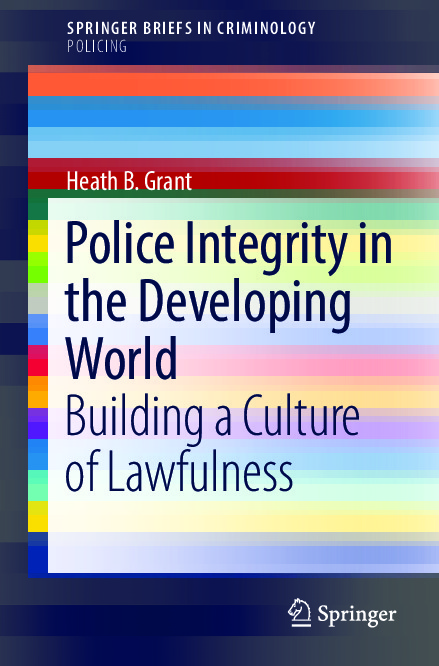File #2326: "2018_Book_PoliceIntegrityInTheDeveloping.pdf"
Testo
1|Contents|6
1|About the Author|8
1|Chapter 1: Antecedents and the Nature of Police Corruption and Impunity in Postcolonial and/or Developing Countries|9
2|Back to the Basics – The Bad Apple in the Bunch|12
2|References|13
1|Chapter 2: Integrity Training: The Importance of a Moral Resoning and Rigorous Evaluations|15
2|Defining Police Integrity|15
2|Individual Level Integrity|15
2|Organizational Level Integrity|16
2|Scope of Integrity Training|16
2|Pedagogical Techniques in Integrity Training|17
2|Content of Integrity Training|17
2|Moral Reasoning as an Integrity Promotion Tool|18
2|References|20
1|Chapter 3: Change in Police Organizations – Towards a Top Down/Bottom Up Strategy|21
2|References|23
1|Chapter 4: Why Civilian Oversight is NOT the Answer – Addressing Use of Force and Other Human Rights Violations|25
2|References|27
1|Chapter 5: Rethinking Community Policing – Collective Efficacy First|28
2|References|30
1|Chapter 6: The Not So Exemplary Example – Bangladesh National Police|31
2|Politics and the Police in Bangladesh|32
2|The Ever-Present History of Partition|32
2|Varied Attempts at Police Reform|35
2|Community Policing: Strengths, Flaws, Implementation and the Importance of Local Context|37
3|Key Lessons for Implementing Community Policing Models in the Developing World|37
2|The Need for a Moderate Level of Police Legitimacy|39
2|Collective Efficacy as a Starting Point|41
2|Summary and Recommendations Moving Forward|42
2|References|42
1|Chapter 7: Tying It All Together – I’m Smarter than a Ninth Grader – The Culture of Lawfulness Model and Its Origins in the Schools|44
2|Taking It to the Police|45
2|Education in the Rule of Law for Police|46
2|Conclusion|49
2|References|50
1|Correction to: The Not So Exemplary Example – Bangladesh National Police|51
1|About the Author|8
1|Chapter 1: Antecedents and the Nature of Police Corruption and Impunity in Postcolonial and/or Developing Countries|9
2|Back to the Basics – The Bad Apple in the Bunch|12
2|References|13
1|Chapter 2: Integrity Training: The Importance of a Moral Resoning and Rigorous Evaluations|15
2|Defining Police Integrity|15
2|Individual Level Integrity|15
2|Organizational Level Integrity|16
2|Scope of Integrity Training|16
2|Pedagogical Techniques in Integrity Training|17
2|Content of Integrity Training|17
2|Moral Reasoning as an Integrity Promotion Tool|18
2|References|20
1|Chapter 3: Change in Police Organizations – Towards a Top Down/Bottom Up Strategy|21
2|References|23
1|Chapter 4: Why Civilian Oversight is NOT the Answer – Addressing Use of Force and Other Human Rights Violations|25
2|References|27
1|Chapter 5: Rethinking Community Policing – Collective Efficacy First|28
2|References|30
1|Chapter 6: The Not So Exemplary Example – Bangladesh National Police|31
2|Politics and the Police in Bangladesh|32
2|The Ever-Present History of Partition|32
2|Varied Attempts at Police Reform|35
2|Community Policing: Strengths, Flaws, Implementation and the Importance of Local Context|37
3|Key Lessons for Implementing Community Policing Models in the Developing World|37
2|The Need for a Moderate Level of Police Legitimacy|39
2|Collective Efficacy as a Starting Point|41
2|Summary and Recommendations Moving Forward|42
2|References|42
1|Chapter 7: Tying It All Together – I’m Smarter than a Ninth Grader – The Culture of Lawfulness Model and Its Origins in the Schools|44
2|Taking It to the Police|45
2|Education in the Rule of Law for Police|46
2|Conclusion|49
2|References|50
1|Correction to: The Not So Exemplary Example – Bangladesh National Police|51

